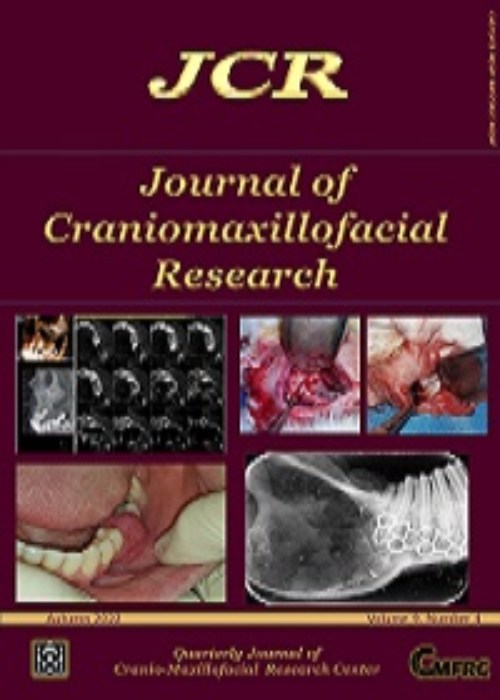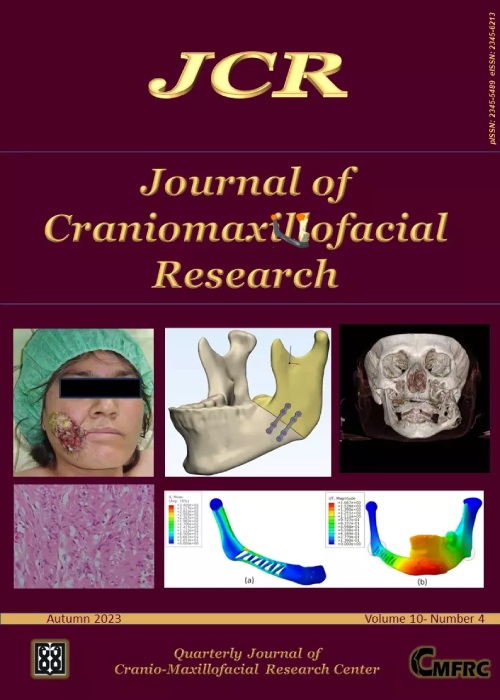فهرست مطالب

Journal of Craniomaxillofacial Research
Volume:9 Issue: 4, Autumn 2022
- تاریخ انتشار: 1402/04/17
- تعداد عناوین: 6
-
-
Pages 162-169
Statement of the Problem:
Using plate and screws as the conventional bone fixation method in maxillofacial fractures leads to many complications as plate exposure, infection or unpleasant feeling on touching. Finding a substitute fixation method has been a far desire for many years.
PurposeThis study compared the new bone formation using an experimental bone adhesive containing a functional monomer (benzophenone tetracarboxylic di-methacrylate, BTDMA) and the conventional plate and screw in fractured mandibles of rabbit.
Materials and MethodThis is an experimental animal study. The artificial fractures were induced at the mandibular angles of three male New Zealand rabbits. Screw and plate were used as control and titanium mesh with the resin-based bone adhesive containing 15 wt. % BTDMA monomer were applied as treatment. The mandible radiography were obtained and the density of the fracture line was compared to the control. The newly formed bone was assessed by a microscope.
ResultsThe results obtained from the MTT cytotoxicity assay showed that 70% of cells were able to grow in the presence of the adhesive. The radiographic density of mesh-adhesive specimens was 119.88±76.29, while conventional plate specimens’ density was 120.38±73.89. The average new bone formation score in the mesh specimens and plate specimens was 3.67±4.62 and 7±4.36, respectively. There was no significant difference between the two groups. The application of bone adhesive containing 15% BTDMA monomer in a group of the rabbits showed lamellar bone formation.
ConclusionUsing bone adhesives containing BTDMA could lead to a new bone formation with high density in the case of adequate bonding to the fractured area.
Keywords: Fractures, Bone, Bone cements, Osteogenesis -
Pages 170-175Background
Microscopically, oral Squamous Cell Carcinoma (SCC) spreads more than the gross tumor. Thus it is recommended to resect the tumor with a proper safe margin. The aim of this study was to evaluate the correspondence between clinical and histopathological margins in oral SCC.
Materials and MethodsSamples were collected from patients diagnosed with oral SCC and referred to Iran Cancer Institute in 2015. All margins of tumors were determined by a marker and then the tumors were resected with 1cm safe margin. The superior, inferior, left and right borders were marked and examined microscopically. The lowest distance between tumor cells and border of resected tissue was considered as pathological margin. The cases with pathological margin less or more than 5 millimeters were classified as close and free margin groups, respectively.
ResultsForty-four specimens (20 females and 24 males), definitely diagnosed as SCC, were examined. The mean age was 61 years old. 19 cases (43.2%) were in the mandible; 23 cases (52.3%) in the tongue and 2 cases (4.5%) in the maxilla. 16 cases (38.4%) were free margin and 28 cases (63.6%) were close margin and the mean pathological margin was 3.52mm.
ConclusionFor some cases, especially SCCs of the mandible, 1-centimeter margin is not adequate to achieve free margins, thus evaluating tumor location, size and stage for more resection seems worthwhile and advisable and can decrease the risk of relapse after resection.
Keywords: Squamous cell carcinoma, Clinical margin, Histopathological margin -
Pages 176-183Background
The present study was designed to evaluate the knowledge and attitude of the sixth-year dental students of Zanjan University of Medical Sciences regarding the principles of oral biopsy and cytology.
Materials and MethodsThis cross-sectional study was concocted on 70 of the final year dental students of Zanjan University of Medical Sciences in 2021. The data was collected in the census method. The data collection tool was a researcher-made questionnaire, the first part of which included demographic information (n=3) and the second part related to students’ knowledge (n=10) and performance (n=4) of the principles of biopsy and oral cytology. Before distributing the questionnaire, its validity and reliability were confirmed. The data was entered into SPSS24 software and Spearman’s rank correlation coefficient and Independent sample t-test were used to analyze the data.
ResultsThe mean and (±SD) of the age of the students was 24.84±1.72 years and 31 (44.3%) were men. The mean (±SD) scores of students’ knowledge and performance of biopsy were 4.41 (±1.12) and 0.68 (±0.60), respectively. Also, students’ knowledge and performance regarding oral cytology were 0.51 (±0.63) and 0.47 (±0.58), respectively. There was no statistically significant relationship between gender and age variables with knowledge and performance levels in the biopsy and cytology sections (P-Value>0.05).
ConclusionOur study showed students’ knowledge and performance of oral biopsy was moderate, while their knowledge and performance of oral cytology was very poor, therefore, it seems necessary to provide solutions to increase students’ knowledge and performance.
Keywords: Knowledge, Performance, Biopsy, Cytology, Dental student -
Pages 184-192
Coronavirus disease-2019 (COVID-19) was identified as a significant threat to health worldwide. During dental procedures, large amounts of aerosols are produced; therefore, dentists, the staff, and patients are exposed to the virus. The present study aimed to evaluate the observation of infection control protocols in dental offices during the COVID-19 pandemic based on the Centers for disease control and prevention (CDC) guidelines in Zahedan, Iran, in 2020-2021. The present descriptive study was carried out with the collaboration of general dental practitioners and specialists in 11 clinics and 133 private dental offices in the public and private sectors in Zahedan, who were active during the COVID-19 pandemic in 2020-2021. The simple sampling method was used, and the data were collected using a checklist prepared based on the guidelines of the CDC. The dentists’ personal protection score was 63%, with 73% for the patients and clients. The mean scores for the personnel’s educational requirements, patients’ and clients’ educational requirements, screening, and personal protection equipment in the dental centers were 76%, 60.5%, 71.8%, and 81%, respectively. The observation of the infection prevention protocols in the dental offices in Zahedan by dentists, staff, and patients was moderate, necessitating further and more appropriate programs to improve it based on the CDC guidelines. Continuous education programs are necessary for dentists, with further information for the general population through the mass media and virtual social networks. periodic studies are necessary to evaluate the efficacy of these programs so that modifications in the policies can be implemented if necessary.
Keywords: Centers for disease control, prevention, U.S, Covid-19, Sars-cov-2, Dental offices, Infection control, Pandemic -
Pages 193-196
Calcifying epithelial odontogenic tumor (CEOT) or Pindborg tumor is a rare tumor that accounts for <1% of all odontogenic tumors. It usually affects patients between the 3rd and 4th decades of life, however a wide age range from 8 to 92 years has been reported. This neoplasm may be associated with erupted or unerupted teeth. There are both intraosseous and extraosseous variants of CEOT and the posterior part of mandible is the most common location. We present an interesting case of CEOT involving the left side of the maxilla associated with unerupted canine and premolar in an 11 year old girl.
Keywords: Odontogenic tumor, Pindborg, Pathology -
Pages 197-200
Fibrosarcomas is an uncommon connective tissue growth that rises from the proliferation of malignant fibroblasts. Local recurrence is frequent, but metastasis is rare. About 0.05% of cases are affected in the head and neck. We report a case of mandibular fibrosarcoma in a 30-year-old man who presented with intraoral swelling in the ridge of the left mandibular alveolus. Histopathology showed the proliferation of malignant fibroblast cells arranged in a classic herringbone pattern.
Keywords: Fibrosarcoma, Fibroblast, Malignancy, Lower jaw, Spindle cell tumor, Oral cavity


